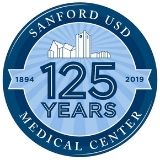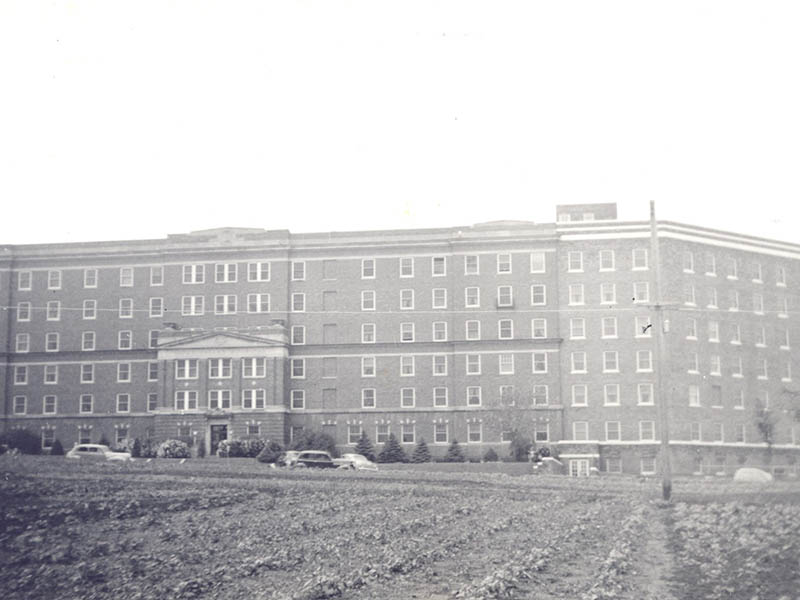
The means of delivering care changed dramatically, in a variety of ways, during the time that Lyle Schroeder served as administrator of Sioux Valley Hospital from 1961 to 1997.
Take a look at something as commonplace now as air conditioning. It’s hard to imagine any building without it on a sweltering summer day. It’s especially hard to imagine a hospital without it, filled with patients and employees — and a surgical unit on the sixth floor.
Schroeder worked at the Sioux Falls, South Dakota, hospital in the early 1950s as an Augustana University student. His first duties involved washing those surgery walls in the afternoons, then rubbing them down with ammonia. Before air conditioning, operations tended to get scheduled for the cooler mornings.
A small group of retired nurses, who started working in the late ’40s to early ’50s, gathered recently to reminisce about their own histories with Sanford Health. They had plenty to say about working before air conditioning.
Gen Walker, a 1947 graduate from the Sioux Valley Hospital School of Nursing, worked in that sixth-floor surgery. “The doctors would get through operating, and their gowns would be soaking wet,” she remembered.
Dee Whitney, a 1953 nursing graduate, recalled working in an office during the day in 1954, then the 7-11 p.m. shift in the hospital. Everyone was hot and miserable, from the patients she settled in for the night, who slept on rubber sheets, to Whitney, who would end up with a drenched uniform.
“Air conditioning was a godsend,” Walker said, and the others agreed emphatically.
The 1964 west wing opened with air conditioning in each room. By 1976, all patient areas of the hospital had received air conditioning, according to the book “An Institution of Organized Kindness,” written by nurse Narcy Recker at the time of Sioux Valley Hospital’s 100th anniversary.
The rise of specialties
When Schroeder started leading Sioux Valley Hospital, he describes it as similar to every other hospital in the state — just a little bigger. Gradually, bringing specialists onto the staff helped Sioux Valley become a regional medical destination. But that took time.
“The smaller communities were reluctant, many times, to send the patient to Sioux Falls because they were fearful that they might not get the patient back. They also thought that was a blatant advertisement that there were better physicians in Sioux Falls than what was in their community,” Schroeder said.
“It took a while for the outlying area to realize that you could refer a patient to a doctor in Sioux Falls, and you’d get that patient back.”
Some general practice doctors within Sioux Valley Hospital held a similar fear, Schroeder said. Wary of specialists with training and credentials they didn’t have, they spent some time observing a vascular surgeon, for example. Then they reconsidered their attitude.
“The doctors, being smart people, realized that these people that had more training than they had — that there was a place for them around the table,” Schroeder said.
Besides, general practitioners already had plenty on their plates. Typical hospital duties included admitting patients, making rounds twice a day, being on call and often caring for obstetrical patients. Many of them did surgery as well. And in the days before the emergency room had full-time staff, Schroeder recalls about 17 doctors on a rotation. Each served in the emergency room for one day every 17 days.
Retired nurse Arlayne Ruhaak, a 1951 nursing school graduate, remembers the low-key emergency department: one room, little equipment. Often, she said, “the ambulance would bring the patient right up to the floor.”
Nurses recall cleaning toilets, dusting
Nurses’ roles have changed a bit, too. Whitney describes what a typical list of tasks looked like at one time: give patients bed baths if needed, help the patients get up, make their beds, change the linens, change the water in their flowers, dust the dressers and clean the toilets.
“The only thing we didn’t do was the floor — we didn’t have to clean the floor,” Whitney said.
They also dished up, sometimes first mixing, medications for patients. They took down orders from doctors and went through patients’ charts each day.
An extra duty might include washing rubber gloves, including turning them and powdering them for re-sterilization. At one time, nurses also had to wash the glass syringes, taking them apart and sterilizing them, as well as sharpening the needles with a stone board.
High patient numbers could throw an extra challenge into the day. When patients outnumbered rooms, sometimes beds would get curtained off at the end of hallways, said Sharon Mathison, a 1960 nursing school graduate.
“It was kind of awkward, but you made do,” she said. “I felt sorrier for the patients than for us.”
Care from nursing students
The nursing school began nearly as early as the hospital. The Sioux Falls Training School for Nurses began in 1899 as a two-year course at Sioux Falls Hospital, according to Recker’s book. The last class graduated in 1986. But while the school operated, students in training played a crucial part in helping provide care for patients.
That tradition continued when Dee Whitney attended nursing school. She and the other retired nurses recall paying $300 total for their three-year tuition. The school provided room and board on the hospital campus, along with laundered uniforms. The students had no summer break — instead, they kept going to classes (some at night) and working.
“Our senior year, we worked full shifts, mostly nights, and went to school,” Whitney said. “They got a lot of work out of us.”
Gen Walker, whose Sioux Falls parents “were very poor,” could start nursing school in 1944 thanks to the U.S. Cadet Nurse Corps, which provided a free education to help address the nursing shortage during World War II.
“When I went into training, (the hospital) was out in a cornfield,” Walker said. “There wasn’t anything around except for one house across the street. And 22nd Street was the end of the city.”
Enlarge

Courtesy of Siouxland Heritage Museums
Days and nights in school
Walker’s school days started early, with mandatory devotions at 6:30 a.m. before a work shift started at 7 a.m. She especially remembers the piano player at devotions — though not necessarily fondly. “She just beat on those keys to wake me up,” she said.
Work shifts varied, according to the timing of classes. Looking back now, the retirees marvel at the amount of responsibility they had just a little while out of high school, and particularly in their last year of training. “We ran the hospital,” Whitney remembered. “When we worked nights, there was one registered nurse on.”
Walker remembers two students working together on a ward at night. “If you had a problem, you called a supervisor,” she said.
And were there problems? Oh, yes, the retired nurses answered, erupting in laughter.
“But we learned a lot,” Whitney reflected.
‘An explosion’ in advancements
Health care is a field where the learning never stops. Schroeder certainly saw that as technology advanced dramatically throughout his leadership. Medical imaging tools and computers combined with scientific discoveries to transform health care.
“There were so many things, that it was really an explosion,” he said. “It impacted all specialties of medicine, whether you were in obstetrics, or whether you were in surgery, whether you were in orthopedics. Things were just blooming and coming out of the scientific world that helped the doctors and, consequently, helped the patients.”
Advances and recruiting helped lead the health system into new specialties. “Many times, we had the only service in the immediate area, like we had the first neonatal unit, we had the first cardiac care unit, first cardiac surgery, those kinds of things,” Schroeder said. “And I think that was kind of a celebration that the employees would have, knowing that they were kind of the leaders of what was going on.”
Paul Hanson, the current president of Sanford Health’s Sioux Falls region, remarked about the speed and ease that patients’ data can get transmitted today.
“We’ve got so many young people that are so gifted … and they’re so bright, and they can get information so quickly,” Hanson said.
“I think the ability for them to access information that quickly is only going to benefit this organization going forward … being able to personalize medicine in such a way that it makes you better.”
More about the hospital’s history
- Part 1: Tracing memories in Sanford Health’s 125-year mission
- Part 2: Sanford Health’s history of service to patients, community
- Sanford Health timeline: Rented house to regional network
…
Posted In Company News, Emergency Medicine, Family Medicine, Innovations, News, Rural Health, Sanford Stories, Sioux Falls
